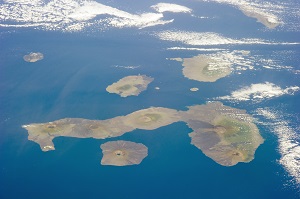
The Galapagos are a group of oceanic islands made up of 15 main islands, 42 islets, and 26 rocks and reefs. Located in the Pacific Ocean, the islands were created when lava rose from the sea bed. The region also has a marine reserve of 79,900 square kilometers.
The differences between the islands' habitats are noticeable. Higher regions have ferns and
sedges
, or plants with triangular stems and unnoticeable flowers that primarily grow on wet ground. The hillsides are covered by evergreen forests, where humidity in the islands increases with altitude. In contrast, the lowland coastal lands are dry and arid, meaning that they don't receive much rain, and therefore don't grow much vegetation. The vegetation in these areas is mostly cacti, in fact.
The Galapagos Islands host many different animals and are home to the only known marine iguanas. Since they are marine animals, they have partially webbed feet and feed on seaweed. There are seven variations of marine iguanas, which are spread throughout the islands.
The giant tortoise, another species that inhabits these islands, weighs between 300 to 400 pounds. There also used to be 15 races of tortoise, four of which are now extinct. The islands are additionally home to two different species of seal: the Galapagos fur seal and the Galapagos sea lion. The fur seal is an intelligent creature that only comes out during the night, while the sea lion comes out during the day. Seven hundred and fifty thousand pairs of seabirds can also be found living on the islands. For example, Galapagos Finches, originally from South America, have evolved into 13 species, each of which now has distinguishable features.
There are many other animals that live on the islands, such as the masked booby, the indigenous Galapagos penguins, and the Galapagos dark-rumped petrel. Scientists are still studying the island wildlife and making new discoveries all the time. Recently, for instance, they discovered a living species of giant rat that was previously thought to be extinct.
One of the first scientists to study the Galapagos Islands was Charles Darwin. He used much of what he observed on these islands to explain his theory of evolution. There are still many more discoveries to be made in the Galapagos; these islands are full of rich biodiversity and intrigue!
[Source:
100 Great Wonders of the World
]

